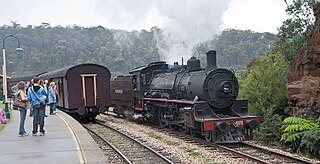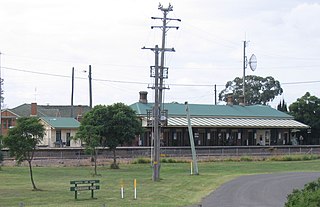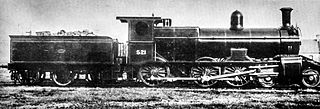
The Zig Zag Railway is an Australian heritage railway, situated near the town of Lithgow in the state of New South Wales. It was opened by the not for profit Zig Zag Railway Co-op. Ltd. as an unpaid volunteer staffed heritage railway in October 1975, using the alignment of the Lithgow Zig Zag line that formed part of the Main Western line between 1869 and 1910. The line climbs the western flank of the Blue Mountains, using railway zig zags to gain height.

Valley Heights is a small township of the City of Blue Mountains in New South Wales, Australia. It is about 70 km (43 mi) from Sydney and is located east of the township of Springwood. At the 2006 census, Valley Heights had a population of 1,337 people.

Singleton railway station is a heritage-listed railway station located on the Main Northern line in New South Wales, Australia. It serves the town of Singleton. It was added to the New South Wales State Heritage Register on 2 April 1999.

The NSW Rail Museum is the main railway museum in New South Wales, Australia. A division of Transport Heritage NSW, it was previously known as the New South Wales Rail Transport Museum (NSWRTM) and Trainworks.

3801 is a 4-6-2 steam locomotive operated by the New South Wales Government Railways between 1943 and 1974. It is arguably Australia's most famous steam locomotive, being the only one to have visited all mainland states and territories.

The Lachlan Valley Railway Society is an Australian rail preservation society based in the New South Wales Central Western town of Cowra. It was established in 1974 to preserve and operate former New South Wales Government Railways locomotives and rolling stock. It operates regular heritage train tours to a variety of locations across New South Wales.

The Spirit of Progress was the premier express passenger train on the Victorian Railways in Australia, running from Melbourne to the New South Wales border at Albury, and later through to Sydney.

The 46 class was a class of mainline electric locomotive built by Metropolitan-Vickers and its partner Beyer, Peacock and Company in England for the New South Wales Government Railways.

The Valley Heights Locomotive Depot Heritage Museum, also known as the Valley Heights Rail Museum, is a railway museum located in Valley Heights, New South Wales, Australia. It is operated by the Blue Mountains Division of Transport Heritage New South Wales.
The railways of New South Wales, Australia, use a large variety of passenger and freight rolling stock. The first railway in Sydney was opened in 1855 between Sydney and Granville, now a suburb of Sydney but then a major agricultural centre. The railway formed the basis of the New South Wales Government Railways. Passenger and freight services were operated from the beginning. By 1880, there was a half hourly service to Homebush.

The G Class are a class of diesel locomotive built by Clyde Engineering, Rosewater and Somerton for V/Line between 1984 and 1989.

The Southern Aurora was an overnight express passenger train that operated between Australia's two largest cities, Sydney and Melbourne. First-class throughout, including the dining facilities, the Southern Aurora featured all-sleeper accommodation. The train first ran on 16 April 1962 after the opening of the North East standard gauge line from Melbourne to Albury, eliminating the break-of-gauge between the capital cities.

The Inter-Capital Daylight was a passenger train that operated between Australia's two largest cities, Sydney and Melbourne from March 1956 until August 1991.

The AA class was an express passenger locomotive that ran on the Victorian Railways between 1900 and 1932. The largest, heaviest and most powerful 4-4-0 steam locomotive to run in Australia, it was the final development of this locomotive type in Australia.

The C32 class was a class of steam locomotives built for the New South Wales Government Railways of Australia.

Locomotive 3642 is a two-cylinder, simple, non-condensing, coal-fired superheated, 4-6-0 36 class express passenger steam locomotive built for the New South Wales Government Railways in 1926 by Clyde Engineering. It is one of three 36 class locomotives that were preserved.

Locomotive 3526 is a two-cylinder, simple, non-condensing, coal-fired superheated, 4-6-0 New South Wales C35 class locomotive express passenger steam locomotive. The only C35 class left in existence, and is operational. The class is commonly referred to as Nannies or Naughty Nannies due to their pre-1924 class designation of NN.

The U sets were a type of electric multiple unit operated by the New South Wales Government Railways and its successors between September 1958 and November 1996. They were nicknamed U-boats.
In 2013 Transport Heritage NSW was established by the Government of New South Wales to manage rail heritage in NSW following an independent review.

Valley Heights Steam Tram Rolling Stock is a heritage-listed collection of tramway machinery at 17b Tusculum Road, Valley Heights, City of Blue Mountains, New South Wales, Australia. It was built from 1889 to 1891. The property is owned by Steam Tram and Railway Preservation (Co-op) Societ. It was added to the New South Wales State Heritage Register on 21 October 2016.



















